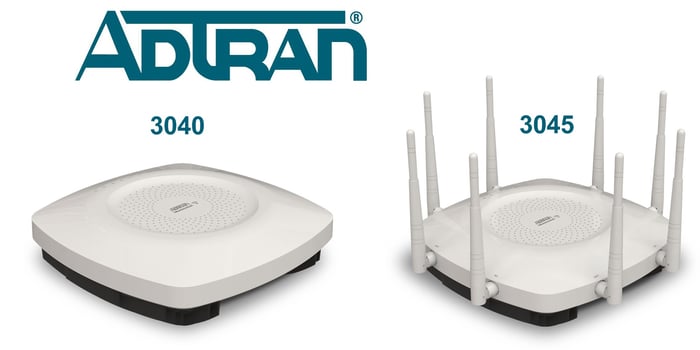 ADTRAN is one of the companies on the forefront of WiFi and mesh networking solutions, with a particular focus on being ready for increasing use of mobile devices in BYOB scenarios. Their various BlueSocket WiFi Access Points have consistently been among the most powerful, flexible, and easy-to-use solutions on the market for businesses dealing with a large number of unmanaged mobile devices.
ADTRAN is one of the companies on the forefront of WiFi and mesh networking solutions, with a particular focus on being ready for increasing use of mobile devices in BYOB scenarios. Their various BlueSocket WiFi Access Points have consistently been among the most powerful, flexible, and easy-to-use solutions on the market for businesses dealing with a large number of unmanaged mobile devices.
The new ADTRAN 3040 and ADTRAN 3045 APs carry on this tradition, becoming the new top-of-the-line in ADTRAN WiFi hardware. These APs are powerful, simple to deploy, and intended to make it easy for businesses of any size to implement future-focused WiFi policy.
We just got some in stock and have been trying them out, so here's what we think.
A Hummingbird First Look At: ADTRAN 3040 and 3045 Access Points
First, to address the most obvious question: The only significant difference between the 3040 and the 3045 is that the 3040 utilizes internal broadcast antennas, while the 3045 features eight external RP-SMA antenna ports which you can populate with antennas of your choice (sold separately).
Otherwise, the 3040 and 3045 are cutting-edge 802.11ac Wave 2 APs, along with a/b/g/n backwards compatibility. In both cases, eight of the antennas are dedicated to WiFi transmission, divided up with four devoted to 5ghz broadcasts and four for 2.4ghz frequencies. Combined, this gives it a maximum theoretical throughput of about 2.5Gbps, with 1.733Gbps over 5ghz and 800Mbps over 2.4ghz.
Both models also feature two additional (internal) antennas, one for scanning\monitoring the local radio environment and the other for providing Bluetooth Beacon functionality. Power comes via PoE+, although an AC adapter can be purchased separately if needed.
So far, so good. This is fairly standard for high-end 802.11ac Wave 2 APs these days. What makes the 3040/3045 different from previous models?
Upgrades To The ADTRAN Bluesocket 3040/3045
One of the big upgrades to the 3040/3045 over previous BlueSocket APs is that they now each feature a multi-gigabyte 2.5Gbps Ethernet uplink, which still retains backwards compatibility with 100/1000 connections. This is in addition to the standard 10/100/1000BaseT connector. So, businesses which have already upgraded to multigig connections can immediately get full functionality out of their 3040/3045.
Another upgrade is that the local area scanning radio is dual-band, giving it superior awareness of the radio frequency environment. This allows your 3040/3045 APs to superior radio optimization functions. Additionally, it features superior Wireless Intrusion Detection Systems (WIDS) which can easily detect rogue access points or attempted attacks. You also get a built-in stateful firewall for standard-grade direct attack prevention.
Plus, these APs were designed with mobile usage in mind. The 4x4:4 MU-MIMO antenna array, with high-gain receiving capabilities, allows the 3040/3045 to easily pick up faint transmissions from low-power user devices.
The Famous ADTRAN Ease Of Use
One thing that hasn't changed about the Bluesocket 3040/3045 APs is ADTRAN's dedication to simple usage. Like all Bluesocket products, these feature "zero touch" deployment. Once you have the ADTRAN software installed on your systems, deploying a new Bluesocket AP only takes a couple minutes. You plug it in, and you input its serial number into your software dashboard. That's it. It automatically handles all other configuration for itself.
Likewise, the ADTRAN dashboard is among the easiest-to-use GUIs on the market, allowing you to quickly set global policies or micromanage individual devices - if you need to. If not, ADTRAN networks practically administrate themselves.
Overall, the new ADTRAN Bluesocket 3040/3045 models fit perfectly into the ADTRAN lineup. They might not be revolutionary, but they're a great evolutionary step forward for the brand.











